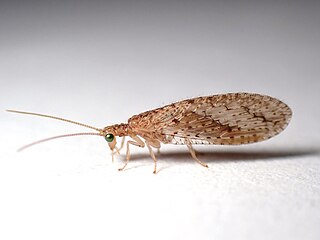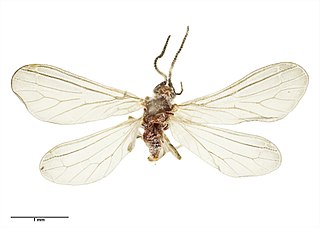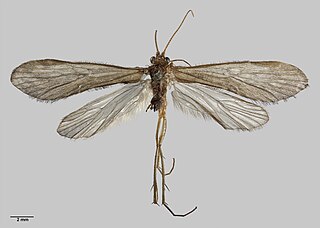Robert McLachlan FRS was an English entomologist specializing in the study of lacewings (Neuroptera) and caddisflies (Trichoptera).

Chrysopa is a genus of green lacewings in the neuropteran family Chrysopidae.

Weeleus acutus is an antlion of the tribe Distoleontini, and the sole member of the genus Weeleus. It is endemic to New Zealand, and is widely distributed, being recorded from Kerikeri to Wakatipu. This species was first described by Francis Walker in 1853 from a specimen presented by Andrew Sinclair.

Micromus tasmaniae, known as the Tasmanian brown lacewing, is a species of brown lacewing in the family Hemerobiidae. It is widespread in Australia, New Zealand, and Pacific Islands such as New Caledonia and Vanuatu.

Chrysopa oculata is a species of green lacewing in the family Chrysopidae. It is found in North America and Central America. This species was imported to New Zealand in 1926, as a way to control aphid populations, however did not establish in the country.

Mallada basalis is a species of green lacewing in the family Chrysopidae, first described by Francis Walker in 1853. No subspecies are listed in the Catalog of Life. The species was detected on mainland New Zealand in the 2010s.

Cryptoscenea australiensis is a species of lacewing in the subfamily aleuropteryginae, first described by Günther Enderlein in 1906. No subspecies are listed in the Catalog of Life. The species is present in Eastern Australia, Tasmania and New Zealand, including the Kermadec Islands.

Drepanacra binocula, known as the Australian variable lacewing, is a species of brown lacewing in the family Hemerobiidae, found across Australia and New Zealand, including Lord Howe Island, Norfolk Island and the Kermadec Islands.

Micromus bifasciatus, is a species of Australasian brown lacewing in the family Hemerobiidae that was first described by Robert John Tillyard in 1923.

Protobiella zelandica is a species of New Zealand beaded lacewing in the family Berothidae that was first described by Robert John Tillyard in 1923. It is the sole known species in the genus Protobiella, and the only berothid endemic to New Zealand. No subspecies are noted in the Catalogue of Life.

Heteroconis ornata is a species of Australian lacewing that was first described by Günther Enderlein in 1905. The species is found in Queensland and New South Wales. The species was first recorded in New Zealand in 1988, and by the late 1980s a small colony was found to be established in West Auckland.
Mnesarchella stellae is a species of primitive moths in the family Mnesarchaeidae. It is named in honour of Gibbs' mother Florence Stella Gibbs. This species is endemic to New Zealand and can only be found in the Nelson area for recording specimen localities as described by T. K. Crosby. This species is the largest in the Mnesarchella genus but otherwise is similar in appearance to other species contained in that genus. This species prefers very damp, dark native beech forest with plentiful moss and lives at altitudes of between 420 and 750 m. Adults of this species are on the wing in December and January.

Stenoperla prasina is a species of stonefly belonging to the family Eustheniidae. This species is endemic to New Zealand and is classified as "Not Threatened" under the New Zealand Threat Classification System. It is found on the North, South and Stewart Island / Rakiura Islands as well as on Little Barrier Island. Although adults of this species are most often coloured bright green, this species can be coloured yellow. This species inhabits clean, cold, running streams and rivers with stony bottoms within native bush. It is a known indicator of water quality. The larvae eat plant detritus and other aquatic insects while the adult insects feed on sooty mould fungi as well as other plant matter. The adults of this species are a known food source for New Zealand long tailed bats. Adults have been dissected and have been found to have been carrying Nematomorpha and trematode parasites. The New Zealand Department of Conservation classifies this species as "Not Threatened". In 2022 a specimen of this species was the 5 millionth specimen to be digitised in the Natural History Museum, London collection.

Keith Arthur John Wise, often referred to as K. A. J. Wise, was a New Zealand entomologist. Originally employed at the Department of Scientific and Industrial Research, Wise began working with the Bishop Museum in the early 1960s, coordinating field programmes for United States visits to Antarctica and Subantarctic islands. This work led Wise to identify and describe large numbers of novel species, including many species of springtail. In 1965, Wise became the first Curator of Entomology at the Auckland War Memorial Museum, where he was integral in creating the first entomology section within the natural history gallery.

Hydrobiosis is a genus of caddisflies belonging to the family Hydrobiosidae. The genus was first recognised by Robert McLachlan in 1868.

Oeconesus is a genus of caddisflies belonging to the family Oeconesidae. The genus was first recognised by Robert McLachlan in 1862. All known species of Oeconesus are endemic to New Zealand.

Pycnocentrodes is a genus of caddisflies belonging to the family Conoesucidae. The genus was first recognised by Robert John Tillyard in 1924. All known species of Pycnocentrodes are endemic to New Zealand.

Olinga is a genus of caddisflies belonging to the family Oeconesidae. The genus was described by Robert McLachlan in 1868, revising the genus name in 1894. All known species of Olinga are endemic to New Zealand.

Pycnocentrodes aeris, also known as the common stony-cased caddisfly, is a species of caddisfly belonging to the family Conoesucidae. The species was first described by Keith Arthur John Wise in 1958, and is endemic to New Zealand.
Orthopsyche is a genus of caddisflies belonging to the family Hydropsychidae. The genus was described by Alex G. McFarlane in 1976. Species of Orthopsyche can be found in New Zealand and New Caledonia.


















